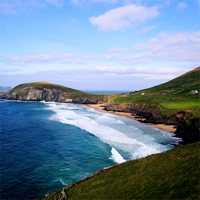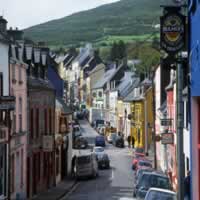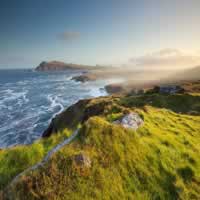COUNTY KERRY - DINGLE PENINSULA



Once described by the National Geographic Traveler as `the most beautiful place on earth,` the Dingle Peninsula is a place of intense allure, with a surplus of green landscapes, rocky hills, long sandy beaches, astounding cliff edges and the staggering splinter-slatted mass of rocks that defines the extraordinary coast at Slea Head. The warm Gulf Stream reaches the peninsula, contributing to its wonderful mixture of sometimes rare and unusual flora and fauna. It is a place of intense, shifting beauty. The region is littered with relics from both the Stone Age and Bronze Age and, more recently, the Ecclesiastical period, when Ireland was known as the `land of Saints and Scholars,` due to its high number of monasteries and religious schools. The Dingle Peninsula is also associated with the film industry. Ryan`s Daughter was filmed here, as were parts of Far and Away, which starred Tom Cruise.
The Dingle Peninsula protrudes 10 miles wide from the southeast of Ireland. It runs 40 miles from Tralee to Slea Head, the point in Europe that is closest to North America. Its highest peak is Mount Brandon, which, at 3,300 feet, is the country`s second tallest mountain. You are advised to give yourself about four hours to travel the 30-mile road circuit of the peninsula by car, as you will want to stop off at many of its beautiful spots. Dingle is one of Ireland`s Government-protected Irish (Gaelic)-speaking areas, called `Gaeltachts.` Dingle`s Irish name is Daingean Uí Chúis which, to fit on signposts, is generally abbreviated to An Daingean. The area is also very popular with cyclists. Some of the most noteworthy stops on the Peninsula tour include the village of Inch, which has a glorious beach, the now uninhabited Blasket Islands, and the Gaelic-speaking Ballydavid and Ballyferriter.


Dingle Town
Dingle town is the heart and soul of the peninsula. It is the most westerly town in Europe and a stronghold of the arts. The town also has a long history. In medieval times the harbor was the departure point for pilgrims to the grave of St James at Santiago de Compostela in Spain. So important was the pilgrimage that the Spanish are said to have built the first church on the site of the present Church of Ireland in Main Street, which is called St James` after the Spanish patron.
Mountains at its back, Dingle faces comfortably onto a sheltered harbor. From level ground at Strand Street on the harbor`s edge and at the Mall beside the Dingle River, three main streets rise: Green Street, John Street and Main Street. About 1,200 people live in Dingle, but it serves the larger population of the surrounding countryside, and in the summer months it caters for many visitors.

The Blasket Islands
In the 1920`s and 1930`s the Blasket Island writers produced books which are deemed classics in the world of literature. They wrote of Island people living on the very edge of Europe, and brought to life the topography, life and times of their Island. They wrote all of their stories in the Irish language. Sadly, the Blasket Island community declined as a result of the persistent emigration of its young people, until eventually the Island was abandoned in 1953 when only 22 inhabitants remained.
The Great Blasket Island remains uninhabited today, but visitors can travel by ferry over to this remote and wildly beautiful place and spend several hours or all day marveling at its natural beauty and what remains of years of human endeavor.
The Blasket Center in Dún Chaoin celebrates the story of the Blasket Islanders, the unique literary achievements of the island writers and their native language, culture and tradition. Situated on the tip of the Dingle Peninsula it is a fascinating heritage center/museum honoring the unique community who lived on the remote Blasket Islands until their evacuation in 1953.

The Conor Pass
The Conor Pass is the highest mountain pass in Ireland, and provides the most dramatic and scenic way of entering or leaving Dingle. This narrow, twisting road runs between the town of Dingle and Kilmore Cross on the north side of the peninsula, where roads fork to Cloghane/Brandon or Castlegregory. The views from the road are breathtaking, as the glaciated landscape of mountains and Corrie lakes comes into view. From the scenic carpark at the summit there are views as far as the Aran Islands off County Galway.
Cycling on the Dingle Peninsula
Cycling the Dingle Peninsula has always been recognized as the ideal way to experience the area`s breathtakingly beautiful views while pedaling through a combination of dramatic mountain climbs or flat valleys that stretch for miles.
There are a number of established bicycle rental outlets dotted around the peninsula where bicycles can be rented by the day or for longer periods. You`ll be happy you left the car or bus behind as you explore the many ancient archaeological ruins and savor the superb coastal scenery at a leisurely pace.